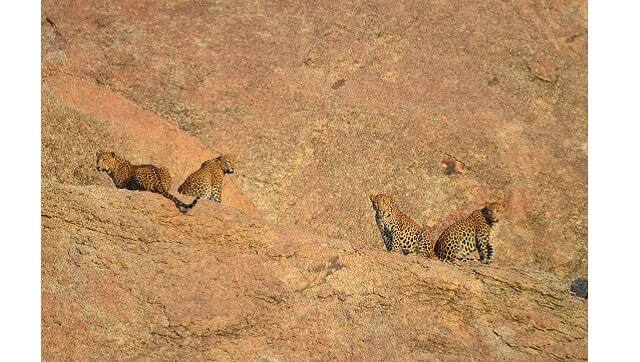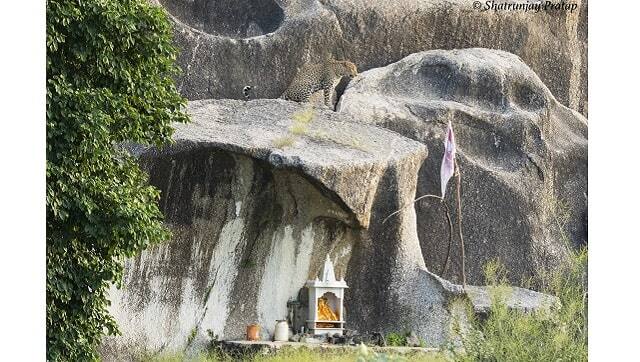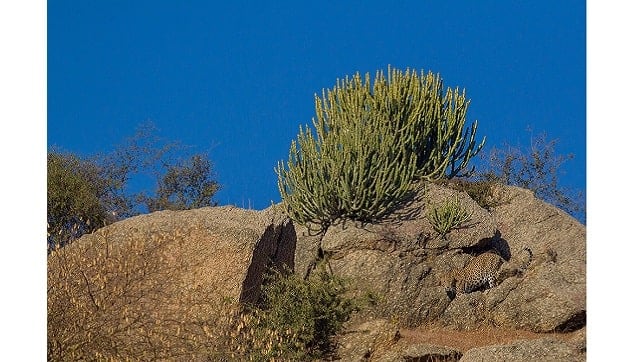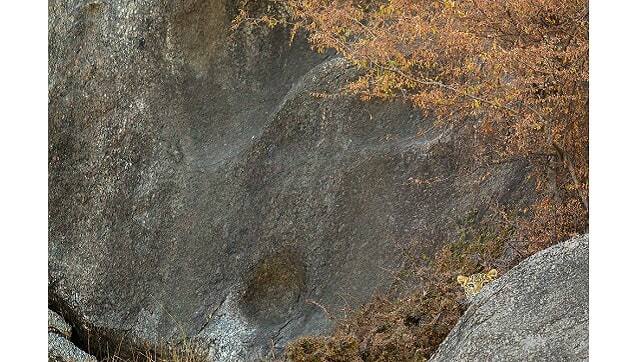The shrill whistle of a distant locomotive pierces the tranquil morning air. There is a momentary silence among the six men who huddle around a dying fire, inching closer every few minutes to make the most of the smoking embers. A dense fog hangs all around them, bringing visibility down to a few feet. At first light, the landscape gains some semblance: On one side are open fields that lead to a few huts in the distance; a couple of hundred metres away on the other, are granite outcrops, dotted with shrubs and cacti. It’s the cue for them to return to the Gypsies and get down to business. The lazy winter sun gradually spreads its warmth, as their hands emerge from the shawls, now holding binoculars and scopes. They train their sights on the hill directly in front of them and wait with bated breath. In the next few minutes, peacocks sound a warning and scatter from their vantage point, as two leopard cubs tumble down the slope, ready for play on a brand new day. From behind them emerges their graceful mother, scoping the scene all around her and soaking in the crisp morning air. After a quick stretch, she settles down on a rock to get toasty, her thick winter coat resplendent in the sunshine. For the next hour, the trigger-happy onlookers have their fill of the family, before the wild cats retreat to the comfort of their cave. The promise of this glorious setting was enough reason for wildlife enthusiast Sundeep Bhutoria to make his first trip to Bera in 2016. This was once an obsolete village located around 140 km from Udaipur. The Jawai Bandh built in 1957 drew migratory birds such as the Greater Flamingo and Sarus crane, but it was the everlasting bond between the leopards and the locals that first brought the region into prominence. This relationship that has blossomed amid a stunning setting is what Bhutoria captures in his latest book, The Bera Bond. “It’s a unique coexistence of human and wildlife, a shining example of harmonious cohabitation which is celebrated without sullying the sanctity of Bera,” Bhutoria says. [caption id=“attachment_9468661” align=“alignnone” width=“640”]  Image © Shatrunjay Pratap Singh[/caption] While leopards can be found all the way from the Narali-Kumbalgarh area, north of Bera, to Mount Abu near the Gujarat border, it’s the 20 sq km around Jawai Bandh where around 55 of them have found a secure haven, according to Bhutoria. It’s an unusual connect between the felines and the Rabari community comprising shepherds and farmers. Wildlife conservationist and photographer Shatrunjay Pratap Singh, who has been visiting the area for decades and finally settled here in 2014, has seen the leopards completely dependent on the locals for survival. Also read: Wildlife biologist and conservationist Sanjay Gubbi on why there's little understanding about leopards in India “Almost 99 percent of their prey base is domestic livestock belonging to the Rabaris, who are believers of Lord Shiva. If you notice Shiva’s image, there’s even a leopard skin draped around him. So the locals do not harm the leopards even when their animals are killed and think of it as an offering to God,” Singh says. “In fact, a few of them even refuse compensation for their animals that is offered by the forest department or local hoteliers. There has never been a case of poaching or attack on humans either,” he adds. [caption id=“attachment_9468671” align=“alignnone” width=“640”]  Image © Shatrunjay Pratap Singh[/caption] According to a 2018 census, India has 12,852 leopards, up 60 percent from the 2014 estimate. However, their adaptability has made them omnipresent across various landscapes in India, leading to regular confrontation with humans. The Wildlife Protection Society of India reported 653 leopard deaths across the country in 2020 and 171 so far this year. The hillocks that dot the Bera region are then a secure refuge for the leopards, who are known to descend after sundown, go about business under the cover of darkness, before returning to the heights. The locals on their part keep out of the way when the leopards are out on the prowl. However, they are also known to share space on occasions without any conflict. For instance, a Shiva temple on Perwa hill is frequented by villagers, who’ve often encountered the leopards on their visits. Local lore also features a priest, Maharaj Amar Nath, who dwelled alongside the leopards, much like the rest of the populace does today. That in turn has led to a flourishing leopard population and a rush of wildlife lovers over the last few years. “You don’t really expect a leopard in this landscape, let alone spotting four together, which is a very rare phenomenon. I spent five days in Bera and saw 12 different leopards, which is just not possible elsewhere. If you go to Kabini for instance, you’ll be lucky to spot just one up a tree,” says award-winning wildlife photographer Prakash Ramakrishnan, who is best known for his stunning image of a common leopard and a melanistic leopard in the Nilgiris. [caption id=“attachment_9468681” align=“alignnone” width=“640”]  Image © Prakash Ramakrishnan[/caption] It would all have been very different, if not for concrete steps taken a few years ago. There were 12 mines allotted in the area and another 144 in the pipeline. Singh got together with the other locals to oppose the mining and their efforts finally bore fruit in 2015 when all permissions were cancelled. The next step to secure the area is to get it declared as a community reserve, given that a majority of it is private land belonging to the local villagers. “Recently, panchayats of three villages, Villar, Chamunderi and Lundara in Pali have unanimously agreed to form a community reserve. The proposal has been sent to the state government and is awaiting approval,” Bhutoria says. However, other issues have emerged over the last few years with the area gaining popularity. Hotels and guesthouses have rampantly cropped up to cater to the tourist influx, besides unregulated safaris that have little regard for rules or wildlife. “Commercialisation is important for conservation, but it has to be responsible commercialisation,” Singh says. [caption id=“attachment_9468691” align=“alignnone” width=“640”]  Image © Prakash Ramakrishnan[/caption] Bhutoria further highlights how overhead electricity lines have posed a danger to the leopards. Besides, a railway line runs right through the area, which is currently being expanded and is only going to get more busy in the days ahead. Over the years, Singh has seen everything from domestic animals to a leopard and crocodile being run over by the locomotives. “The 15 km stretch between Falna and Keshavganj is a deathtrap and needs to be fenced. It’s only then that animals will use the underpasses that have been constructed. This is just the beginning for this region, so it’s a good time for the government to step in and do something about it,” Singh says.
Wildlife enthusiast Sundeep Bhutoria’s book, The Bera Bond, evocatively captures the relationship between locals and leopards in Bera, Rajasthan.
Advertisement
End of Article


)
)
)
)
)
)
)
)
)



